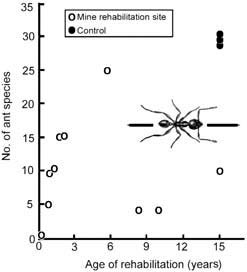Box 1.2. Tramp ants and biodiversity
No ants are native to Hawai’i yet there are more than 40 species on the island — all have been brought from elsewhere within the last century. In fact all social insects (honey bees, yellowjackets, paper wasps, termites, and ants) on Hawai’i arrived with human commerce. Almost 150 species of ants have hitchhiked with us on our global travels and managed to establish themselves outside their native ranges. The invaders of Hawai’i belong to the same suite of ants that have invaded the rest of the world, or seem likely to do so in the near future. From a conservation perspective one particular behavioral subset is very important, the so-called invasive “tramp” ants. They rank amongst the world’s most serious pest species, and local, national, and international agencies are concerned with their surveillance and control. The big-headed ant (Pheidole megacephala), the long legged or yellow crazy ant (Anoplolepis longipes), the Argentine ant (Linepithema humile), the “electric” or little fire ant (Wasmannia auropunctata), and tropical fire ants (Solenopsis species) are considered the most serious of these ant pests.
Invasive ant behavior threatens biodiversity, especially on islands such as Hawai’i, the Galapagos and other Pacific Islands (see section 8.7). Interactions with other insects include the protection and tending of aphids and scale insects for their carbohydrate-rich honeydew secretions. This boosts densities of these insects, which include invasive agricultural pests. Interactions with other arthropods are predominantly negative, resulting in aggressive displacement and/or predation on other species, even other tramp ant species encountered. Initial founding is often associated with unstable environments, including those created by human activity. Tramp ants’ tendency to be small and short-lived is compensated by year-round increase and rapid production of new queens. Nestmate queens show no hostility to each other. Colonies reproduce by the mated queen and workers relocating only a short distance from the original nest — a process known as budding. When combined with the absence of intraspecific antagonism between newly founded and natal nests, colony budding ensures the gradual spreading of a “supercolony” across the ground.
Although initial nest foundation is associated with human- or naturally disturbed environments, most invasive tramp species can move into more natural habitats and displace the native biota. Ground-dwelling insects, including many native ants, do not survive the encroachment, and arboreal species may follow into local extinction. Surviving insect communities tend to be skewed towards subterranean species and those with especially thick cuticle such as carabid beetles and cockroaches, which also are chemically defended. Such an impact can be seen from the effects of big-headed ants during the monitoring of rehabilitated sand mining sites, using ants as indicators (section 9.7). Six years into rehabilitation, as seen in the graph (from Majer 1985), ant diversity neared that found in unimpacted control sites, but the arrival of P. megacephala dramatically restructured the system, seriously reducing diversity relative to controls. Even large animals can be threatened by ants — land crabs on Christmas Island, horned lizards in southern California, hatchling turtles in south-eastern USA, and ground-nesting birds everywhere. Invasion by Argentine ants of fynbos, a megadiverse South African plant assemblage, eliminates ants that specialize in carrying and burying large seeds, but not those which carry smaller seeds (see section 11.3.2). Since the vegetation originates by germination after periodic fires, the shortage of buried large seeds is predicted to cause dramatic change to vegetation structure.
Introduced ants are very difficult to eradicate: all attempts to eliminate fire ants in the USA have failed. We will see if an A$123 million ($US50 million), five-year campaign to rid Australia of Solenopsis invicta will prevent it from establishing as an “invasive” species. The first fire ant sites were found around Brisbane in February 2001, and two years later the periurban area under surveillance for fire ants extended to some 47,000 ha. Potential economic damage in excess of A$100 billion over the next 30 years is estimated if control fails, with inestimable damage to native biodiversity continent-wide. Although intensive searching and destruction of nests appears to be successful, all must be eradicated to prevent resurgence. Undoubtedly the best strategy for control of invasive ants is quarantine diligence to prevent their entry, and public awareness to detect accidental entry.




